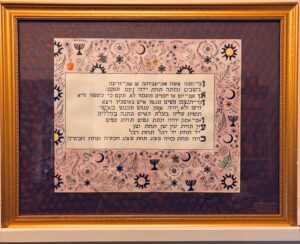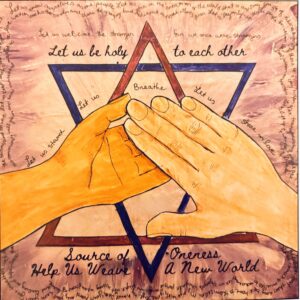Sometime in 2022 I became curious about becoming a brit mitzvah (which is the word my synagogue uses instead of bar or bat mitzvah). When I realized that the 13th anniversary of my conversion to Judaism coincided with my 60th birthday, I took it as divine synergy! Thus began a journey that culminated on February 15, 2025 when I stood before my community and chanted Torah for the first time ever.
My bat mitzvah was a marker along the path of a rich Jewish journey that has held my home congregation, Congregation Bet Haverim (CBH) in Atlanta at the heart, but which has also had me exploring the fringes in what some call Jewitchery. I began calling myself a Jewitch, first almost in jest and then with increasing seriousness. (There is a lot more to be said about this term and my evolving relationship with it, but that’s for a later blog!) So, rather than becoming a bat mitzvah, I became a “witch mitzvah.”
The traditional terms of bat and bar mitzvah literally translate into “daughter/son of the commandment.” A Witch Mitzvah, possibly coined by me, is how I express my connection to Judaism: deeply feminine, Earth-based, and witchy. I seek out the voices and stories of women and trans and non-binary people which have been hidden or actively suppressed in Judaism. The word “witch” was applied to herbalists, midwives, healers, wise women, priestesses, queer people and others who were (and sadly still are) actively hunted throughout history in order to uphold the patriarchy and to erase women’s autonomy, wisdom and agency.
As a crystal-carrying pagan, I was over the moon to find all of my Earth-based reverence possible within Judaism. I already knew that the Jewish wheel of the year turned with the seasons and was a lunar calendar but over the years, I found that all of the rituals, practices, herbalism and, yes, magic, that I practiced as a pagan, existed in Judaism. Sometimes hidden in plain sight. Incantations, amulets, herbal traditions, ritual movement – it’s all here! I am so grateful to the priestesses, rabbis and ordinary folks who have uncovered women’s rituals and traditions and re-energized them.
I have been traveling this path for many years now, and as a Reconstructionist Jewitch, I create new rituals and practices based on ancient traditions. Part of this journey includes a deep dive into my relationship with prayer language.
In 2019, I began using prayers in the feminized Hebrew created by The Kohenet Hebrew Priestess Institute and playing with ungendered Hebrew brought into being by the Non Binary Hebrew Project.
The Kohenet siddur – the priestess prayerbook – uses Goddess and Queen, and the non-binary Hebrew replaces King and Queen with Sovereign. While both of those offer alternatives to a lord and master God, I actually prefer de-personified prayer language, as I don’t resonate with Spirit as King, Queen, or any Sovereign. Rather than using Adonai, which means master or lord, I use Shekinah, which, while it can be thought of as Goddess or the feminine face of God, also describes Spirit as the Indwelling Presence between us, within us and around us. I also use Havaya which means Was, Is and Will Be. I prefer ruach – breath, spirit or wind instead of melech – king.
Ruth Brin wrote:
When men were children, they thought of God as Father;
When men were slaves, they thought of God as a Master;
When men were subjects, they thought of God as a King.
But I am a woman, not a slave, not a subject,
not a child who longs for God as father or mother.
I might imagine God as teacher or friend, but those Images,
like king, master, father or mother, are too small for me now.
God is the force of motion and light in the universe;
God is the strength of life on our planet;
God is the power moving us to do good;
God is the source of love springing up in us.
God is far beyond what we can comprehend.
Her words capture my feelings perfectly and I am grateful to have prayer language which reflects my connection to the ineffable Spirit of mystery.
At my witch mitzvah, I used feminized and ungendered prayer language in a siddur – prayer book – that I created for the occasion. I acknowledged potential discomfort and wrote “It may feel uncomfortable, and you may find your tongue tripping on familiar prayers. We will move a little more slowly in the prayers for that reason. If that feels uncomfortable, I invite you to just notice, to return to your breath and to consider the fact that there are hundreds of metaphors to describe God, and none of them even come close to describing the Great Mystery. Each of you should feel free to use whatever language that best connects you to this moment.”
I presented all of the above as my d’var – word of Torah – which I offered as introduction to my Torah portion. My parsha – portion – was Mishpatim from the book of Exodus. Mishpatim means “laws” or “ordinances,” and contains a very long series of civil, ethical, and ritual laws given to the Israelites. My specific parsha contains laws concerning personal injuries and damages. It’s where you hear the famous ayin tachat ayin – an eye for an eye phrase. It’s a complicated parsha as so many of them are. While I found that it provided immense fodder for reflection, I didn’t actually “like it.”
So I did what any good witch would do and turned to Toratah, the regendered Hebrew Bible. In 2016 artist Yael Kanarek had the chutzpah to rewrite and re-gender the Bible! She was over the patriarchy! And really, who isn’t? She writes, “The Bible has been translated into the largest number of languages ever and has a huge impact on human culture and creativity. It was written over a long period of time, and the process of its sanctification also took hundreds of years. It describes the theology, politics and law of a patriarchal world. The biblical law favors men over women and most of the exemplary figures it paints are male.
The Regendered Bible, by contrast, offers a matriarchal structure for the sacred mythology, for the narratives that establish self and national identity, for politics and the law.” Yael and her writing partner, Tamar Biala, have been rewriting the books with incredible integrity and precision, but they hadn’t gotten to Mishpatim yet. So I wrote to her and asked her if she would do me the honor of providing a translation of my parsha. And she did! So exciting!
But after reading it, I found that a list of laws, punishments, and rules pertaining to enslavement and injury is actually no better in a world ruled by women. Yael and Tamar note this on the Beit Toratah website: “Toratah was born from a feminist consciousness, but it does not reflect a feminist utopia.” I sat with Mishpatim in both Torah and Toratah and found only sadness. The eye for an eye and a bruise for a bruise still existed, and the slave is still a slave. That’s not the world I want to live in.
I have long struggled to develop a relationship with Torah. I have found connection when other people pull out passages and put them in chant form or poetry or art or good divrei Torah – words of Torah. I am moved by these offerings but I have struggled to find my own way through text study and connect with this odd ancient set of writing that is filled with really flawed people making really poor choices and being variously smote by an angry God who claims to be a God of love but asks often really terrible things and wreaks terrible vengeance. So, yeah, Torah, Torahtah. I was bummed.
And then I took the coolest class I’ve ever taken called “Olamic Incantations, crafting poetic incantations that reshape our world from the inside out” led by the wild and fabulous Hebrew priestess, Kohenet Angelique. Olam means world and Olamic, which may be a made up word, means “pertaining to the world.” An incantation, also known as a spell, is a spoken word, phrase, or formula of power, often recited as part of a larger ritual, which is recited in order to effect a magical result. The class on Olamic incantations invited us to write our own sacred liturgy and create prayers for the world that we want to see.
OK, you with me? it’s about to all come together. We have a sad list of punitive responses to injuries and transgressions existing in both Torah and Torahtah and I bring my sadness to this magical class and I am invited to rewrite the parsha using language that describes the world that I want to live in. The world that I want to help speak into being. At this point, I wasn’t envisioning doing anything with the writing, I was just dreaming and writing. I rewrote Mishpatim as an incantation, a plea, a cry to the world – let us create a different world.
Shortly after that I got serious about figuring out what becoming a bat mitzvah entailed and began exploring the formats and the possibilities. I started asking about the rules and what I could or couldn’t do and what I needed to do. And I found out I could do pretty much anything I wanted! And the world swung wide open and brought us to that day in February.
The mystical book called the Zohar describes Torah as Black Fire on White Fire. The black fire is the words themselves. The white fire is the meaning making. The blank space between the letters is where we insert breath and aliveness. Torah is alive. Each time we read or chant or write, we are speaking the aliveness of spirit into being. Conjuring, if you will, the Divine into the space between us. We do it through loving, through singing, through caring for each other, through art, through our breathing. Reconstructing Judaism invites us to dive deeply into the ancient words and to find meaning and relevance for this modern world. Jewitchery builds on that and invites in the power of energy, breath, intent and love to speak into being the world that you want to see.
And so, my offering at my witch mitzvah was threefold, built on a scaffold of energy: first were the verses which I chanted from Torah. I did this traditionally, learning Hebrew, learning the trope – the rhythm – and reading from the actual Torah. That journey alone was profound. Until a year ago, I did not know my whole aleph bet. I am still decoding, but I did it. I learned it and I chanted it, my gabbai sheni – Hebrew guide – and friend standing supportively by my side.
Then I chanted the same verses from Toratah which were beautifully scribed by my beloved. I did a combination of formal trope and improvisation as there are words that are similar and words that are different. I gave myself permission to approach the words with looseness rather than fitting them into the formal trope. Part of the wrestling was allowing women’s voices and experience to rise from the barriers put in place by the eons of male rabbis who blocked access to women’s voices and connection to the Divine through reading Torah. Torahtah is still emerging and being birthed into the world. I am grateful that I was able to bring the work of Beit Toratah to life a little more.

And then I offered my Torah – my Olamic incantation describing the world that I want to see based on the laws written in the parsha. My visual representation of this is below and all three offerings are included at the end. I allowed myself to be open as to how I would share – believing that I would meet the moment and trust that my spirit and voice would know what to do. And I did. As I improvised the tune, I invited the congregation to stand, to join hands, to lift their voices. I sent out my prayer into the world and was held by my community. As soon as I finished the third offering, the chorus burst into Elah as a “spiritual chatimah,” a seal on the experience. I stood in front of the Torah with my extended family by marriage, my beloved, and our two young adult sons in front of a loving congregation composed of nearly everyone whom I adore in the world and felt the most complete that I have ever felt.

The witch mitzvah process was one of the most generative, creative, challenging, healing, and exciting explorations that I have ever done. It involved generational healing, as I explored what was happening in my own family when I was 13, and also wrestling with my changing family dynamics following the death of my beloved mother. It provided opportunity for vulnerability in asking for help and inviting collaborators to make the day happen for me. It involved deep wrestling with patriarchal norms, trudging through the sludge of expectations and assumptions of what it means to be Jewish, to be a woman, to be a woman entering her 60’s, and so much more. It involved leaning even more deeply into what is the ongoing, core challenge of my life: that of living a life of authenticity, listening to spirit and working to create a world that works for everyone; one that centers love of nature and people, one where there is no more hatred. One where people’s hearts are open to the incredible miraculous mystery of being alive on this planet. I had many sleepless nights and shed gallons of tears. I learned Hebrew, for heaven’ sake. I talked my friends’ ears off as I shared my journey with them. I received so much love and support as I brought my questions to folks who hold different insights into Hebrew, Torah, and ritual. I surrendered again and again and again.
I am still integrating the lessons and the experience – there was so much richness and the energy is still shimmering within me and within my community. I am so grateful.
Torah / Toratoh Exodus 21:20-25 מִּשְׁפָּטִים Mishpatim
(כ) וְכִֽי־יַכֶּה֩ אִ֨ישׁ אֶת־עַבְדּ֜וֹ א֤וֹ אֶת־אֲמָתוֹ֙ בַּשֵּׁ֔בֶט וּמֵ֖ת תַּ֣חַת יָד֑וֹ נָקֹ֖ם יִנָּקֵֽם׃
(כא) אַ֥ךְ אִם־י֛וֹם א֥וֹ יוֹמַ֖יִם יַעֲמֹ֑ד לֹ֣א יֻקַּ֔ם כִּ֥י כַסְפּ֖וֹ הֽוּא׃ {ס}
(כב) וְכִֽי־יִנָּצ֣וּ אֲנָשִׁ֗ים וְנָ֨גְפ֜וּ אִשָּׁ֤ה הָרָה֙ וְיָצְא֣וּ יְלָדֶ֔יהָ וְלֹ֥א יִהְיֶ֖ה אָס֑וֹן עָנ֣וֹשׁ יֵעָנֵ֗שׁ כַּֽאֲשֶׁ֨ר יָשִׁ֤ית עָלָיו֙ בַּ֣עַל הָֽאִשָּׁ֔ה וְנָתַ֖ן בִּפְלִלִֽים׃
(כג) וְאִם־אָס֖וֹן יִהְיֶ֑ה וְנָתַתָּ֥ה נֶ֖פֶשׁ תַּ֥חַת נָֽפֶשׁ׃ (כד) עַ֚יִן תַּ֣חַת עַ֔יִן שֵׁ֖ן תַּ֣חַת שֵׁ֑ן יָ֚ד תַּ֣חַת יָ֔ד רֶ֖גֶל תַּ֥חַת רָֽגֶל׃
(כה) כְּוִיָּה֙ תַּ֣חַת כְּוִיָּ֔ה פֶּ֖צַע תַּ֣חַת פָּ֑צַע חַבּוּרָ֕ה תַּ֖חַת חַבּוּרָֽה׃ {ס}
- When a slave-owning party strikes a slave, male or female, with a rod, who dies there and then, this must be avenged.
- But if the victim survives a day or two, this is not to be avenged, since the one is the other’s property.
- When [two or more] parties fight, and one of them pushes a pregnant woman and a miscarriage results, but no other damage ensues, the one responsible shall be fined according as the woman’s husband may exact, the payment to be based on reckoning.
- But if other damage ensues, the penalty shall be life for life,
- eye for eye, tooth for tooth, hand for hand, foot for foot,
- burn for burn, wound for wound, bruise for bruise.
Toratah Exodus 21:20-25 מִּשְׁפָּטִים Mishpatim
כ וְכִי־תַכֶּה֩ אִשָּׁ֨ה אֶת־עַבְדָּתָ֜הּ א֤וֹ אֶת־זְרֹעָהּ֙ בַּשֵּׁ֔בֶט וּמֵ֖תָה תַּ֣חַת יָדָ֑הּ נָקֹ֖ם תִּנָּקֵֽם׃
כא אַ֥ךְ אִם־י֛וֹם א֥וֹ יוֹמַ֖יִם תַּֽעֲמֹ֑ד לֹ֣א תֻקַּ֔ם כִּ֥י כַסְפָּ֖הּ הִֽיא׃ (ס)
כב וְכִֽי־תִנָּצֶ֣נָּה נָשִׁ֗ים וְנָ֨גְפ֜וּ אִ֤ישׁ בַּֽאֲשָׁכָיו֙ וְיָצָ֣א זַרְע֔וֹ וְלֹ֥א יִֽהְיֶ֖ה אָס֑וֹן עָנ֣וֹשׁ תֵּֽעָנֵ֗שׁ כַּֽאֲשֶׁ֨ר תָּשִׁ֤ית עָלֶ֙יהָ֙ בַּֽעֲלַ֣ת הָאִ֔ישׁ וְנָֽתְנָ֖ה בִּפְלִלִֽים׃
כג וְאִם־אָס֖וֹן יִֽהְיֶ֑ה וְנָתַ֥תְּ נֶ֖פֶשׁ תַּ֥חַת נָֽפֶשׁ׃
כד עַ֚יִן תַּ֣חַת עַ֔יִן שֵׁ֖ן תַּ֣חַת שֵׁ֑ן יָ֚ד תַּ֣חַת יָ֔ד רֶ֖גֶל תַּ֥חַת רָֽגֶל׃
כה כְּוִיָּה֙ תַּ֣חַת כְּוִיָּ֔ה פֶּ֖צַע תַּ֣חַת פָּ֑צַע חַבּוּרָ֕ה תַּ֖חַת חַבּוּרָֽה׃ (ס)
- And should a woman strike her servantess or her handservant with a rod, and she dies under her hand, avenged, she shall be avenged.
- But if the victim survives a day or two, this is not to be avenged, since the one is the other’s property.
- And should women fight and they hit a man in his testicles and his semen escapes, and no other harm follows, the one responsible will be punished as the man’s owner will exact and the payment will be based on reckoning.
- But if harm follows, then you must take life for life,
- Eye for eye, tooth for tooth, hand for hand, foot for foot,
- Burn for burn, wound for wound, bruise for bruise.
Exodus from Exodus – Mishpacha*
Source of Strength and Unity,
Let us know ourselves as one people.
Let us join in the creation of the world that is and sing the songs of liberation.
May there be a day when after transgressions, people are helped to find their way home to themselves.
My eye with your eye, my hand with your hand, my foot with your foot
Together we heal the burns and bruises,
Let us lift up the ways of the Divine.
Let us keep each other from open pits, watch each other’s oxen and share grazing land.
Let us put out each other’s fires.
And let us lie only with those people for whom we feel passion and ardor.
Let us connect to ourselves, to nature, and let us be people who walk the paths of magic and delight.
Let us sing incantations of leisure, healing, and hopefulness which all our community will join in and we will truly know ourselves as one people.
Let us open our arms to strangers, for we once were strangers.
Let us help them find their ways and places among us.
Let us know ourselves as one people.
Let us be holy people to each other.
As we stand in the fields and at our doors and on our roads, let us be open.
As we stand, so we breathe,
As we breathe so we share,
As we share so we love,
And together we heal.
Together we thrive
Source of Oneness, together we weave this new world.
Ken Teheye Ritzona/May it be Her Will
*One feature of Hebrew, לשון הקודש, lashon hakodesh, the holy tongue, is that words sharing a core of letters are connected. Changing just one letter, the ט, tet, for a ח, chet, and adding the feminine ending, ה, hei, we transform משפט, mishpat to משפחה, mishpacha, family. (Rabbi Zeitlin)
McKenzie (Ma’ayan Yehudit) Wren is a ritualist who supports connection and growth through Earth-based, embodied practices uplifting the Divine Feminine. Whether facilitating art experiences, ritual or ceremony, workshops or classes, McKenzie creates a space where each person is seen, heard and valued and has an authentic meaningful experience.





